ISSN ONLINE(2319-8753)PRINT(2347-6710)
ISSN ONLINE(2319-8753)PRINT(2347-6710)
Kor Kamonpatana1, PongpunAnuntavoranich2
|
| Related article at Pubmed, Scholar Google |
Visit for more related articles at International Journal of Innovative Research in Science, Engineering and Technology
This study conducts an exploratory study related to a systematic model of decision variables for the vertical farming concept found in Thailand. Utilizing the model of decision variables found in three paradigms, the different available sources of data were synthesized to understand the concept as a phenomenon and to find a valid model for a new construction and product development strategy using the vertical farming concept for Thailand in the future
Keywords |
| vertical farming, urban agriculture, soil-less culture, bioclimatic design, decision variables |
I. INTRODUCTION |
| After the industrial revolution, carbon dioxide emissions from industrial production greatly increased, resulting in climate change and global warming effects that have altered agricultural production in many ways [1]. The rapid growth in the global population and the reduction of agricultural areas has brought about the world’s food security issue. Like many countries, Thailand is affected by climate change whereas urban expansion reduces the country’s cultivation area and quality. Due to the major drought in 2010, many agricultural areas were destroyed. This was again exacerbated by the worst flooding in 2011. ASEAN Early Warning Information reported that Thailand’s rice production declined by 2% during 2008-2010 [2]. These events display that the effects of climate change and are likely to get worse. |
| In 2001, Professor Dickson Despommier from the University of Columbia introduced the vertical farming concept as an alternative to reduce agriculture’s ecological footprint and to produce food and expand the agricultural area in the city [3]. Urban agriculture improves food sustainability for a country [4] and will affect the formation of urban areas through its impact on planning, design and construction [5]. However, to adopt the vertical farming concept and construct urban agriculture is not a straightforward process. There are many variables to consider, for example, cultivation quantity and quality, design and supporting technology, in order to successfully implement vertical farming in the city. |
| Therefore, in order to identify crucial variables related to the development of innovative construction and product development for vertical farming in Bangkok, Thailand, this study explores the decision variables in three different paradigms: 1) urban agriculture and vertical farming, 2) science and technology and 3) architecture and design. |
II. LITERATURE REVIEW |
| Key variables derived from books and research papers related to the vertical farming concept have identified many specific variables either involved or not involved in the design criteria. Relevant variables were summarized to scope the frame of this study (conceptual framework), which consisted of three issues: vertical farming and urban agriculture, science and technology, bioclimatic and vertical garden design. |
| The variables found in these three paradigms were used as a preliminary structure to further the design study of vertical farming in Thailand as follows: |
| 1. Variables in Vertical Farming and Urban Agriculture |
| The variables found in urban agriculture were studied to support food stability in the city. These variables were |
| identified from research papers and books on the issue of vertical farming as: food security, city self-reliance, urban agriculture, and food miles in the context of a country. The variables involved in the design decisions are; |
| Food security |
| FAO has suggested the concept of food security since 1967-1979 during which period the world experienced a shortage of grain and food. The definition of food security includes sufficiency, accessibility, utilization and stability [6]. |
| Isvilanonda [7] found that the population in urban and rural areas is food poor, although food is located in rural areas of the north and northeast, as those farmers who live in the arid zone and out of communication are consider food poor. Even though they use their land to grow rice, which is a basic and essential food, they still possess insufficient amounts of rice in their households. Important variables in this subject are the quantity, quality and access to food. |
| Urban agriculture |
| Urban agriculture refers to crops or livestock in the city and suburban areas, with study in this area determining whether the city is self-reliant in food or not [8]. Urban agriculture is different from agriculture in rural areas due to the mixture of two variables (the economy and ecosystem) with agriculture. The key variables are city self-reliance and food accessibility. |
| Food miles |
| Food miles are defined as the distance which food travels from farm to market to consumer [9]. A weighted average source distance is calculated from the distance and the amount of food transported [10]. The total transport distance is calculated beginning at the farmer’s land, then through the food production and trading processes until it reaches the consumer. The greater the distance the food is transported, the greater are the greenhouse gas emissions. Evaluation of food miles in Europe is divided into two categories: food miles in the country and international food miles. Food miles provide an indicator for the environment, society and economy of food production, which affect the sustainable development of the city [11]. |
| An important variable in this subject is the distance food is transported from producers to consumers. |
| Concept of Vertical Farming |
| In 2001, Dickson Despommier, the professor of Environmental Health Science at Columbia University, proposed a concept to reduce agriculture's ecological footprint by using vertical farming which built agriculture into the city and expanded it in vertical direction. The concept has been discussed widely and is under continuous study at present [2]. Dickson Despommier discussed problems associated with urban agriculture on a limited land base. To solve this problem, he proposed the concept of creating crop cultivation in buildings that enables the production of large amounts of food. The vertical farming concept, if applied to Thailand, can be conducted with greater effectiveness because of the warm climate when compared to planting in places with a cold climate [12] since there is no need to grow vegetables in a closed environment, which requires climate control. |
| Key variables in this concept are: economic feasibility, food security, urban agriculture, architecture, design and technology. |
| 2. Variables in Science and Soil-less Culture Technology |
| In the past, Thailand has embraced hydroponics technology and improved the technology to fit the Thai context. The general principle has been to simplify the technology or to enhance it or to develop new knowledge of the system in the Thai context. |
| Due to the fact that the survival of plants relies on water, light and nutrients, the investments in a hydroponics system or greenhouse [13] were reviewed with the focus on the performance of the components of the greenhouse (such as cladding), on the method to measure the greenhouse system’s performance and on other factors that affect the performance and design of the house such as capital and cost-benefit analysis. Soil-less culture technology involves variables such as capital and planting method and details which depend on the technology used. Key variables of this subject are plant selection, factors essential to the survival of plants, cost-benefit, capital, and planting method. |
| 3. Variables in Bioclimatic and Vertical Garden |
| The variables involved in the design of the plant were identified from existing systems in order to achieve decorative aspects or to promote a better environment surrounding building and to reduce the impact of buildings on the environment. |
| Bioclimatic theory first described by the Malaysian architect, Ken Yeang, explains how to build the shell of the building by utilizing the local environment, focusing primarily on ensuring the optimum conditions for a comfortable living temperature and visibility for the users within the building shell. Second, is the need to rationally manage natural resources, which is directly related to the effort to preserve the environment [14]. |
| Sunakorn [15] tested the carbon dioxide absorption performance of three types of ivy on screening walls and found that Blue Trumpet vine (Thunbergiagrandiflora) has the best performance followed by Confederate vine and gourd. Sunakorn [16] tested the heat reduction performance of shade from tropical vines by selecting the Blue Trumpet vine to conduct an experiment on the impact on room temperature of using or not using vine shading in a room with ventilation and an enclosed room. The results showed that the temperature could be reduced by up to 9.93 ° C, with an average of 3.63 ° C during the day. |
| Variables in this aspect are plant selection, efficiency to reduce heat, and Energy and environmental management. |
III. OBJECTIVE |
| 1. To identify variables related to construction and product development for vertical farming in Thailand. |
| 2. To determine the linkages between variables. |
| 3. To create a linkage model of the variables using the concept of vertical farming. |
| 4. To conceptualize the vertical farming approach for Thailand in accordance with all pertinent decision variables. |
IV. METHODOLOGY |
| This study is divided into five parts as follows: |
| Part 1 |
| Identify the main variables that are relevant to vertical farming development by conducting a literature review of academic research and case studies under three paradigms; 1) urban agriculture and vertical farming, 2) science and technology and 3) architecture and design. |
| Part 2 |
| Investigate the possibilities for the vertical farming concept in Bangkok and verify the key variables and identify the sub variables related to vertical farming development by conducting semi-structured interviews with Thai experts in the three areas, Data was recorded and short noted and investigation was stopped after 11 interviews when the data was considered to have reached saturation level. Data was collected from October 2012 to February 2013. |
| Part 3 |
| Verify variables by the three different methods of data collection: 1) literature review, 2) interview and 3) observation of variables from December 2012 to April 2013. |
| Part 4 |
| Propose a model of decision variables and the linkage model for vertical farming development by using data reduction, interpretation and grouping techniques. |
| Part 5 |
| Conclude the design concept of vertical farming in Thailand. |
V. RESULTS |
| The research results were divided into three parts: |
| Part 1: Relevant Variables to Vertical Farming Development. |
| From the literature review covering the areas of urban agriculture and vertical farming, science and technology, and architecture and design, 15 main variables were identified as being significantly relevant to the vertical farming concept (Table 1). |
| Part 2: Possibilities of Vertical Farming in Thailand and the Related Variables for Vertical Farming Development. |
| Eleven experts (Table 2) identified variables which they considered were associated with urban agriculture in Thailand and 137 sub variables were detected and deemed relevant to the vertical farming concept in Bangkok and were considered helpful in sustaining the development of the city. It was also found that vertical farming promotes stability and food safety, whereby a better environment for society is generated. |
| Part 3: System of Variables |
| The 137 related sub variables were interpreted and grouped into 15 main variables with 52 sub variables. (Figure1). Key variables were identified and their relationship interpreted and then divided into four levels of acceptance: irrelevant, partially relevant, relevant and not available. |
| Basic interpretation for the validity of variables was applied as follows: |
| If the experts could not answer a question, the key variable was considered not available. |
| If the experts mentioned "No, it's ...", "It's not ..." or "Totally not related to …", this was then translated as irrelevant. |
| If the experts mentioned "may be ...", "I cannot at all ...” or I think it will be more relevant in terms of ...", it was translated as partially relevant. |
| If the experts mentioned "I have to ...", "It is important", "important", "That’s what we do", "Totally possible", "Certainly" or "It is proved by”, it was translated as relevant. |
| The results of the survey were interpreted and are summarized in (Table 3). |
| The sub variables mentioned by the experts were also identified as they described the relevance and importance of key variables due to the differences of their purpose, needs and experience. Data was analyzed altogether to find common variables in general terms. For example, the efficiency variable referred to the efficiency of the vertical farming planting system. Some experts with more experience of working with planting systems in a cold climate country mentioned efficiency as having high importance and high demand. However, when this was compared to opinions from others with experience of working with the planting concept in the context of Thailand, high efficiency was likely to be considered redundant because a practical planting method and budgeted system maintenance are more important. |
| All the main variables from the in-depth interviews were confirmed from the literature and were observed in the urban hydro farm businesses in the Bangkok area such as the technology used, design, amount of production and maintenance as shown in (Figure 3). The sub variables based on the interviews were then reduced from 137 to 52 by combining some variable details into general terms, which could then be summarized to include any linkages to other variables (Figure 2) based on the expert’s comments in the context of Thailand, as shown in (Table 3) and (Table 4). |
VI. CONCLUSION AND DISCUSSION |
| This research studied the possibility of implementing vertical farming in Bangkok, Thailand by synthesizing ideas and opinions from 11 experts under three pertinent paradigms which had not previously been reported. The results showed that the vertical farming concept could be adopted in Bangkok in a certain manner that covered several variables that were required to succeed. The relevant variables were grouped into 15 main variables with 52 sub variables. Each variable was related to the others. These variables will be utilized in the future design of vertical farming applications in the city. |
| At present, there are not many vertical planting products or construction projects in the market. The data surveyed suggested a preference for a non-toxic planting system, preferably, a system that could serve the mid- to low-income population, enable the development of a better quality of life, reduce the need for health care and provide toxin-free vegetables. |
| In the area of urban agriculture in Bangkok, rooftop vegetable gardens have been in place for quite some time. Awareness about the importance of self-reliance and responsibility for the environment has been widely acknowledged among certain groups and is gaining popularity. However, the numbers of vegetable gardens in the city which are capable of reducing food transportation costs and promoting self-reliance are still limited and the concept of vertical farming in buildings is very new to Thailand and its cost of implementation is still too high. |
VII. FIGURES AND TABLES |
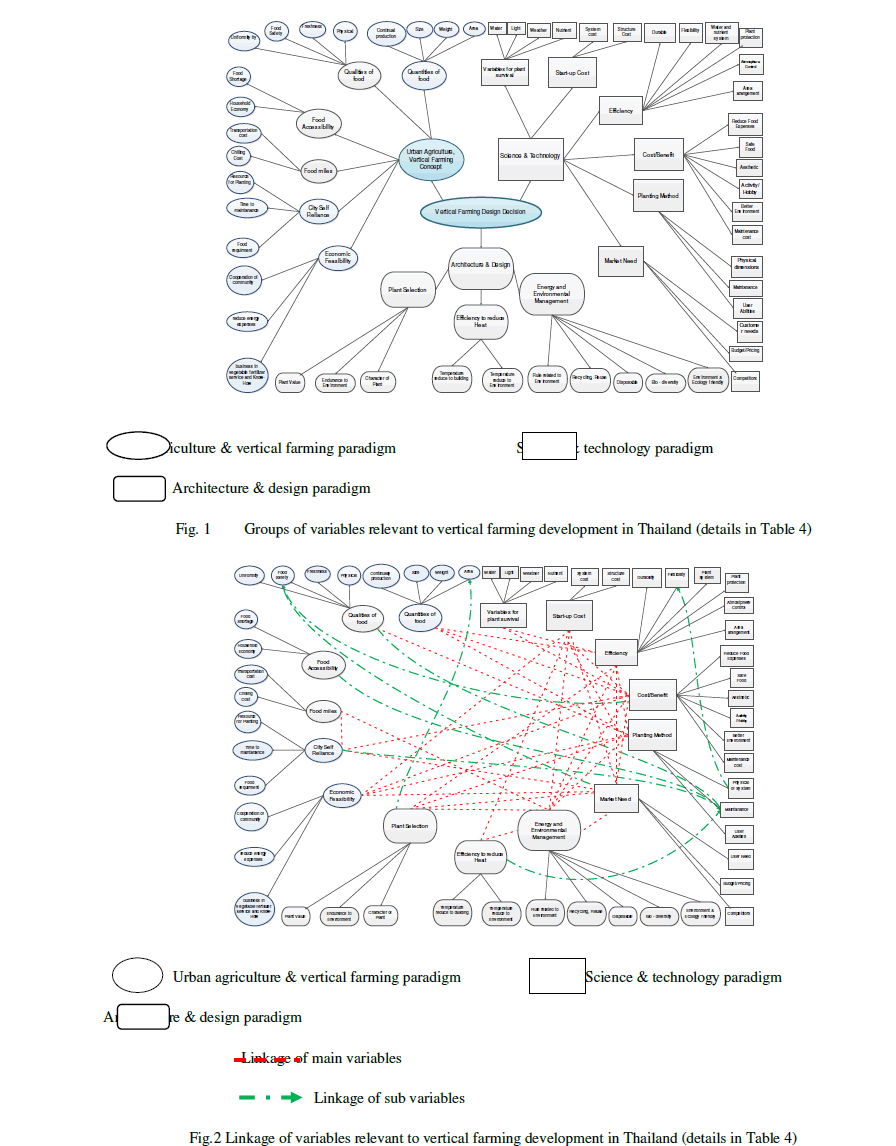 |
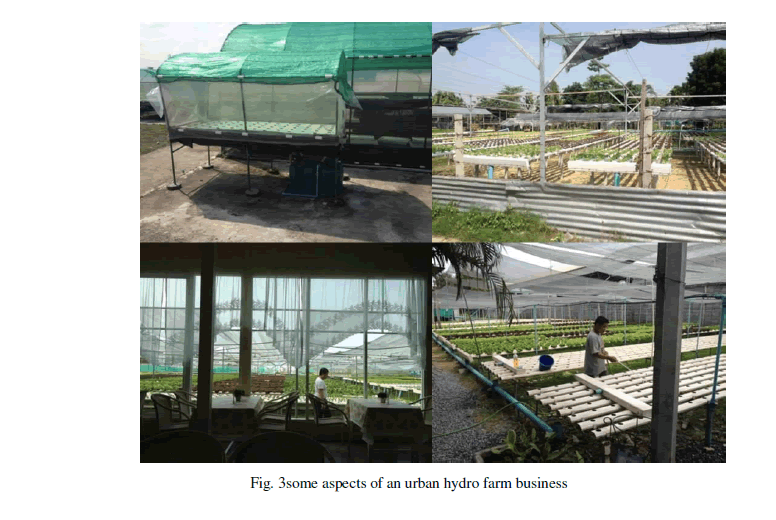 |
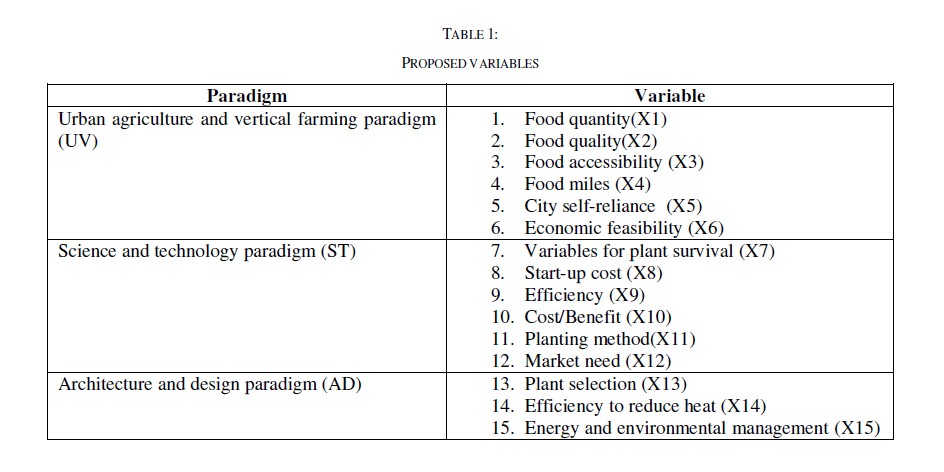 |
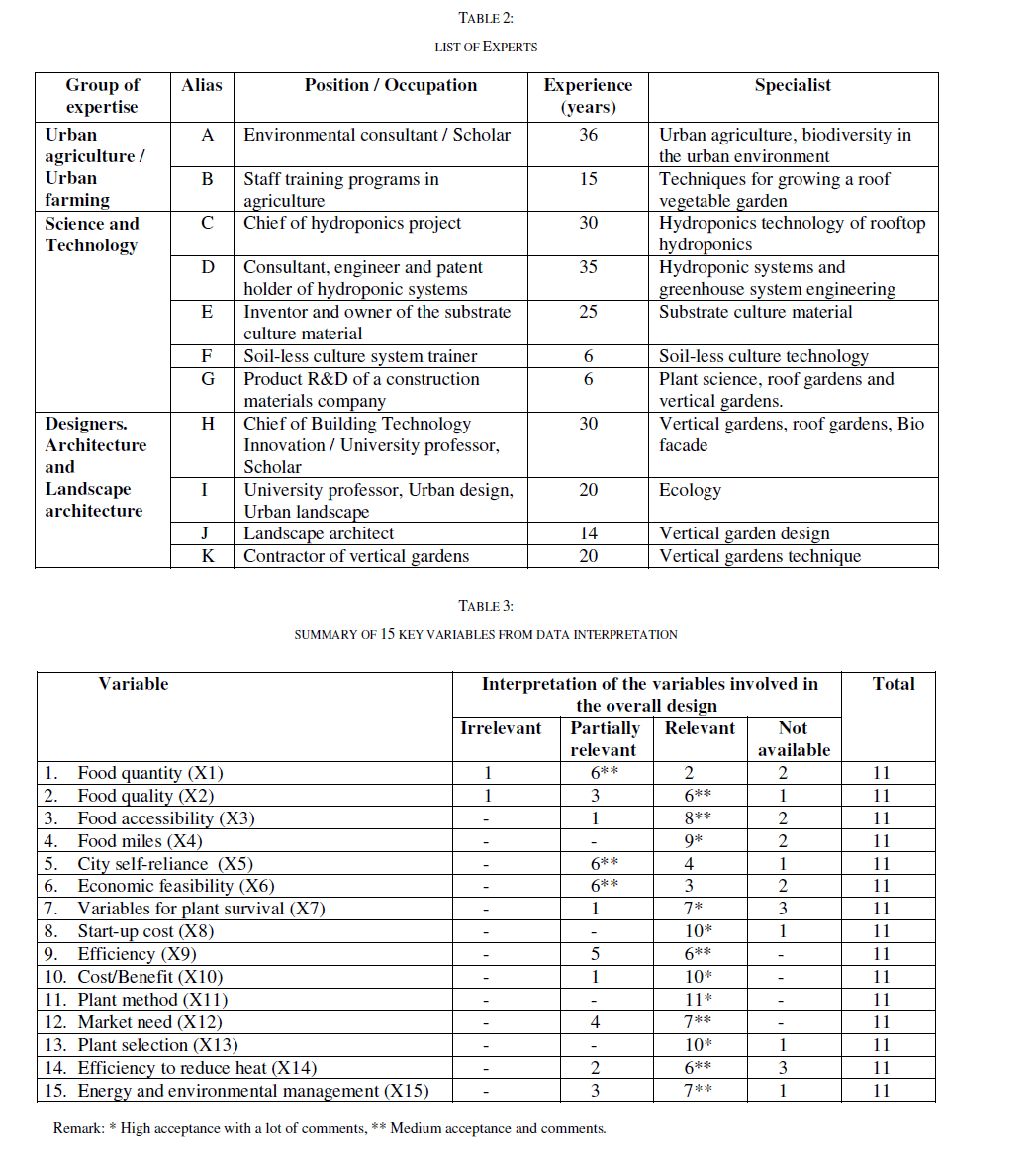 |
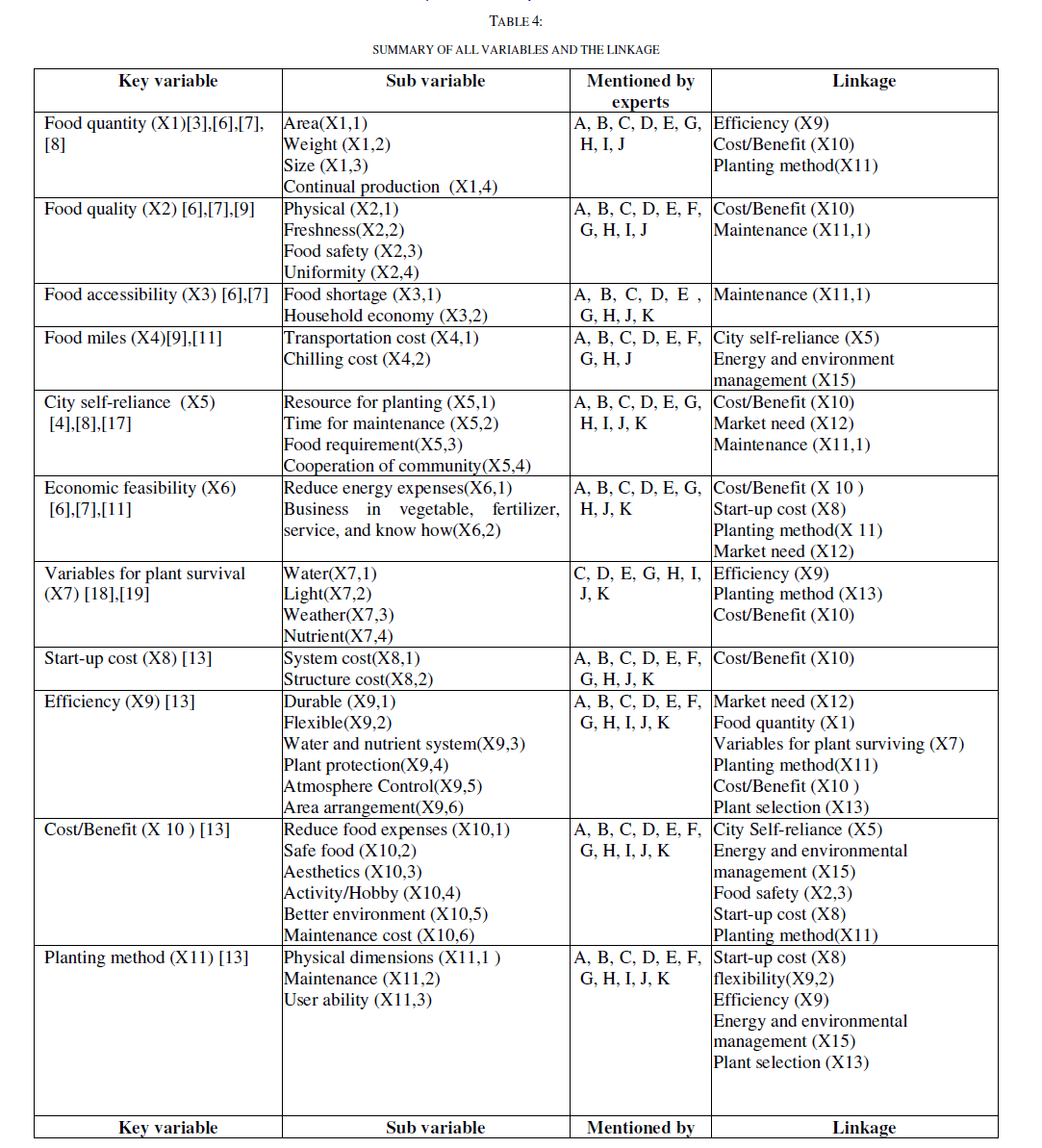 |
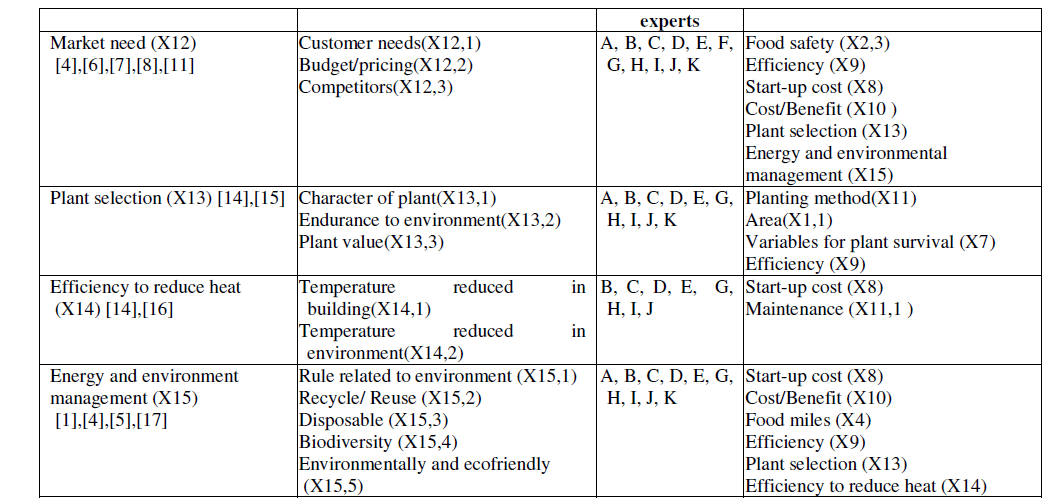 |
References |
|